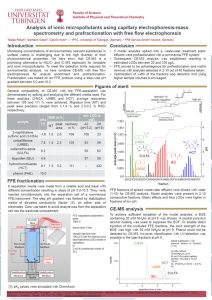Micropollutants
Performance of free flow field-step-electrophoresis as clean-up step for the non-target analysis of environmental water samples.
1 Tobias Rösch, 2 Gerhard Weber, 3 Tobias Bader, 1,4 Anna-Jorina Wicht, 1 Carolin Huhn
1 Institute for Physical and Theoretical Chemistry, University of Tübingen, Auf der Morgenstelle 18, Tübingen, Germany, 2 FFE Service GmbH, Feldkirchen, Germany
3 Zweckverband Landeswasserversorgung, Laboratory for Operation Control and Research, Langenau, Germany, 4 current address: Bayerisches Landesamt für Umwelt, Augsburg, Germany
Corresponding author: Carolin Huhn, carolin.huhn@uni-tuebingen.de
Paper submitted to journal of Analytical and Bioanalytical Chemistry
Abstract
For the analysis of low concentrations of micropollutants in environmental water samples, efficient sample enrichment and clean-up is necessary to reduce matrix effects and to reach low detection limits. For analytes of low and medium polarity, solid phase extraction is used, but robust methods for the preconcentration of highly polar or ionizable analytes are scarce. In this work, field-step electrophoresis (FSE) was developed as an environmental sample clean-up technique for ionizable micropollutants and ionic transformation products. The FSE electrolyte system preconcentrated 15 acidic model analytes (pKa from -2.2 to 9.1) present in aqueous samples in two fractions by factors of 5-10. Simultaneously, highly mobile matrix compounds were removed including inorganic ions such as sulfate and chloride. The fractions were either directly injected for downstream analysis by reversed phase liquid chromatography (RPLC) or further processed by evaporative preconcentration with subsequent reconstitution in an organic solvent suitable for separation methods like hydrophilic interaction chromatography. The FSE/RPLC-MS method exhibited high quantitative precision with RSDs of 3-6%. The method was successfully applied to a spiked river water sample and its performance compared with common solid phase extraction and evaporative concentration, demonstrating a high analyte coverage. FSE combined with non-target screening by RPLC-MS revealed a strong reduction in matrix load especially at low retention times. 17 compounds were identified in the FSE fractions sampled at the field step boundary by retention time, accurate mass and mass fragments. Suspect screening by FSE/RPLC-MS was facilitated by FSE’s selectivity for anionic compounds.
